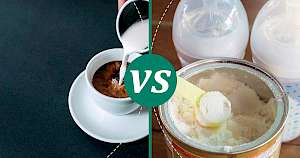Milk Powder vs Coffee Creamer: Calories & Nutrition Showdown


Milk powder vs Coffee creamer
Nutrition Facts
Serving size:
change
5g10g15g20g30g40g50g60g80g100g120g140g160g180g200g220g250g300g350g400g450g500g600g700g800g900g1000g
1oz2oz3oz4oz5oz6oz7oz8oz10oz12oz15oz20oz25oz30oz35oz40oz50oz
Amount Per Serving:
Serving size:
change
5g10g15g20g30g40g50g60g80g100g120g140g160g180g200g220g250g300g350g400g450g500g600g700g800g900g1000g
1oz2oz3oz4oz5oz6oz7oz8oz10oz12oz15oz20oz25oz30oz35oz40oz50oz
Amount Per Serving:
Milk Powder vs Coffee Creamer 100g Compare
| per 100g | Milk powder | Coffee creamer |
|---|---|---|
| Calories | 496 | 136 |
| Carbohydrates | 38.42 g | 11.38 g |
| Fat | 26.71 g | 9.97 g |
| Protein | 26.32 g | 1 g |
| Water | 2.47 g | 77.27 g |
| Calcium | 912 mg | 9 mg |
| Iron | 0.47 mg | 0.03 mg |
| Potassium | 1330 mg | 191 mg |
| Sodium | 371 mg | 67 mg |
| Vitaminium E | 0.58 mg | 0.81 mg |
| Vitaminium K | 0.002 µg | 0.003 µg |
Delving into the World of Milk Powder and Coffee Creamer: A Surprising Comparison
When it comes to enriching our favorite beverages, the choice between milk powder and coffee creamer might seem straightforward. However, this decision packs a surprising amount of depth, history, and nutritional nuances that could sway your preference. Let's embark on an enlightening journey through the intriguing facts and comparisons between these two staples of the modern pantry.
A Peek into the Past: The Origins of Milk Powder and Coffee Creamer
Milk powder, a product obtained by removing water from milk, boasts a rich history dating back to the 1800s. Its invention was driven by the need for a more stable form of milk that could withstand the absence of refrigeration, making it a revolutionary product of its time. On the other hand, coffee creamer, often synonymous with non-dairy creamer, emerged in the 20th century as a lactose-free alternative to milk and cream. Its convenience and versatility quickly made it a favorite among coffee enthusiasts and those with dietary restrictions.
Navigating the Nutritional Landscape
While both milk powder and coffee creamer serve to enhance the flavor and texture of beverages, their nutritional profiles are vastly different. Milk powder, with 496 calories per 100 grams, is rich in proteins, vitamins, and minerals, reflecting its dairy origin. It provides essential nutrients such as calcium, magnesium, and potassium, making it a nutritious addition to any diet.
In contrast, coffee creamer, with its 136 calories per 100 grams, is lighter on nutrients. It's designed to replicate the creaminess and color of milk in coffee without the added dairy components. This makes it a lower-calorie option, but it also means missing out on the nutritional benefits of milk. However, for those managing their dairy intake or looking for a lighter option, coffee creamer offers a convenient alternative.
The Taste Test: Flavor and Versatility
Flavor-wise, milk powder and coffee creamer cater to different palates. Milk powder retains the rich, creamy taste of fresh milk, making it a versatile ingredient not just for beverages but also for cooking and baking. Its ability to reconstitute into liquid milk or be used as a dry ingredient adds a layer of convenience for home chefs and bakers.
Coffee creamer, on the other hand, comes in a variety of flavors, from the classic French Vanilla to the indulgent Hazelnut, offering a customizable approach to coffee personalization. Its ability to dissolve easily in both hot and cold beverages without curdling makes it a favorite for iced coffee aficionados.
Environmental and Dietary Considerations
From an environmental standpoint, both milk powder and coffee creamer have their impacts. The production of milk powder involves significant water usage and dairy farming, which has a notable carbon footprint. Coffee creamer, particularly the non-dairy varieties, often contains palm oil or other ingredients whose production can contribute to deforestation and habitat loss.
For those with dietary restrictions, coffee creamer provides a dairy-free alternative, accommodating lactose intolerance and vegan diets. Milk powder, while not suitable for those avoiding dairy, offers a source of nutrition for those who can consume milk products.
Final Thoughts: Choosing What's Right for You
In the end, the choice between milk powder and coffee creamer boils down to personal preference, dietary needs, and environmental considerations. Whether you lean towards the nutritional richness of milk powder or the convenience and variety of coffee creamer, both options have their unique benefits and uses in our daily lives.
As we continue to explore the vast world of food and nutrition, let's remember the importance of making informed choices that align with our health goals and ethical standards. After all, every small decision contributes to the larger tapestry of our well-being and the planet's health.
Milk powder 100g
496kcalCalories source
- 31% CARBS.
- 21% PROTEIN
- 48% FAT
Coffee creamer 100g
136kcalCalories source
- 33% CARBS
- 3% PROTEIN
- 64% FAT
Compares of milk powder
- Milk Powder vs Whole Milk
- Milk Powder vs Buttermilk
- Milk Powder vs Egg
- Milk Powder vs Butter
- Milk Powder vs Coffee Creamer
- see all compares of milk powder
Compares of coffee creamer
- see all compares of coffee creamer
Read also:
- Calories from Milk powder
- Calories of Pastrami
- Calories in Tomato juice
- Veal calories per 100g
- Persian cucumber protein per 100g
- How many calories does tortellini have?
- Calories in a half of tempeh
- Calories in whole tempeh
- Calories for one, two or more tempeh
- Calories in slice of tempeh
- How much protein in flan?
Marcin Piotrowicz
calories-info.com creator
Healthy diet and healthy lifestyle promoter
Add comment